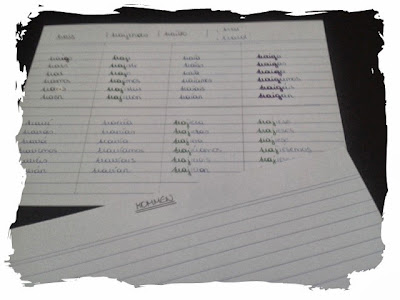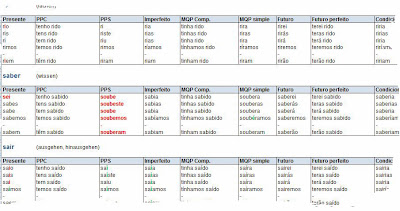This post is also available in: German
I've already spoken about my vocabulary list and today I would like to present a tool with which I learn and repeat verb conjugations. It has the very creative name "verb list".
Background:
For me studying verb forms is a really important matter as I want to speak and write gramatically correct. So I've long thought about a tool with which I can practise conjugations on a regular basis. Obviously, you don't need such a constant repitition as with vocabulary because usually you get to know to conjugations fast and once they're stuck in your head they usually remain there. On the other hand intensive studying is required whenever you learn a new verb tense/mood.
My first real tool I created about two years ago when I wanted to repeat the basic Spanish grammar for university. I realised that one of my problems in understanding the usage of time and moods was that before I could try to understand the meaning of the grammar in the sentence I struggeled to even indentify the tense/mood. I simply hadn't automised yet the recognition of the verb form. So when I started repeating the basic grammar I did the following:
Vocabulary cards:
I used different revising rythms like each day 3 cards etc. Later on I gave it up because I had the feeling that I knew the forms quite well. When I attended a beginners course Portuguese I started the same system but ended up having words only in present tense as I've just now learned more tenses in my 4-romance-languages-project.
The vocabulary cards worked really fine but I had the feeling that it was not the perfect tool for me. Especially when I started to use Anki I prefered to have a digital tool for revising verbs. Furthermore I didn't want to have four different decks of paper cards when starting my 4-romance-languages-project. So I came up with the idea of creating Excel lists.
Verb list:
The idea is simple and I basically do the same as I did on paper before. For each language I created an Excel file. Just like you see on the picture above I created columns for each tense/mood. Instead of creating one card for each verb I but them one under the other in alphabetical order. Here is an example of my Portuguese list:
|
Whenever I come across a new verb which I consider important for the list I add the lines and complete it. When I learn a new tense/mood I study the basic rules on how to build the form and then as a training I conjugate all the verbs which are already in the list. So step by step I compelete the whole list.
The completion of the table is the first revision, the second is that I copy the verb list into the corresponding Anki cards of the verbs. So whenever a verb occurs in Anki I do not only revise the translation but also the conjugation. Depending on my mood I can revise by only reading the whole conjugation or by writing down the conjugation on a sheet of paper and testing myself.
Colour system:
I like to work with colours and I highlight all irregularities. While on the index cards I just used any colour I had at hand, I elaborated a specific colour system for my Excel lists.
- green - irregular accent or change of intonation as e.g. in the Russian conjugation
- violett - "irregularity" due to spelling rules e.g. ç instead of c
- blue - one-letter change, this includes also the vowel transformations in Spanish as sentir: siento, sientes...
- red - complete irregular form as e.g. in PT: pôr: ponho etc.
These colours help me to remember irregularities easier.
I hope you found some helpfull advise and I would be happy about comments/feedback :)
Ich habe ja bereits von meiner Vokabelliste erzählt und heute möchte ich euch meine Verbliste vorstellen. Ihr seht, beim Benennen bin ich immer besonders kreativ.
Hintergrund:
Für mich ist es sehr wichtig, die Konjugation eines Verbs gut zu können, da ich grammatikalisch einwandfrei sprechen und schreiben will. Ich habe lange über ein Tool nachgedacht, mit dem ich die Konjugationen auf regelmäßiger Basis wiederholen kann. Selbstverständlich braucht man diese Verbformen nicht so konstant zu wiederholen wie Vokabeln, denn normalerweise gewöhnt man sich bald daran und hat die meisten Sachen im Kopf. Allerdings muss man vor allem dann mehr Zeit hinein investieren, wenn man neue Zeiten/Modi lernt.
Mein erstes Tool habe ich vor ca. zwei Jahren entwickelt, als ich die spanische Basis-Grammatik für die Uni wiederholte. Mir wurde klar, dass eines meiner Probleme im Erlernen des Zeiten- und Modisystems war, dass ich viel zu lange brauchte, um die Zeit oder den Modus überhaupt erst an der Verbform zu erkennen. Ich hatte die Verbformen einfach noch nicht automatisiert. Daher habe ich folgendes gemacht:
Vokabelkarten:
Ich habe eine Packung in der Größe DIN A5 gekauft und habe für jedes Verb, das mir begegnete, eine Karte angelegt. Auf die Vorderseite schrieb ich einfach nur die deutsche Übersetzung, auf die Rückseite schrieb ich die Konjugation. Ich habe nicht gleich die ganze Konjugation auf einmal geschrieben. Da ich die Grammatik von Null auf wiederholte, startet ich mit dem Präsens. Als ich zum pretérito perfecto compuesto kam, fügte ich das participio hinzu (nicht die ganze zusammengesetzt Konjugation), dann indefinido, imperfecto etc. Alle Unregelmäßigkeiten habe ich mit verschiedenen Farben markiert, allerdings hatte ich zu dieser Zeit noch kein bestimmtes Farbsystem.
Zum Wiederholen hatte ich immer wieder einen anderen Rhythmus, zum Beispiel jeden Tag drei Karten. Irgendwann habe ich dann damit aufgehört, denn ich hatte das Gefühl, dass die Formen saßen. Als ich später dann einen Anfängerkurs Portugiesisch besuchte, habe ich wieder das Gleiche gemacht. Allerdings kam ich damals nicht über die Gegenwart hinaus, denn weitere Zeiten habe ich dann erst in meinem 4-Romanische-Sprachen-Projekt gelernt.
Die Verbkarten haben gut funktioniert, aber ich hatte doch immer noch das Gefühl, dass es nicht zu 100% das Passende war. Vor allem als ich dann anfing, mit Anki zu lernen, wollte ich doch lieber ein digitales Tool haben. Außerdem wollte ich für mein 4-Romanisches-Sprachen-Projekt keine vier verschiedenen Stapel and Papierkarten haben. Dann kam mir die Idee mit der Excel-Liste.
Verbliste:
Die Idee ist total simpel und eigentlich mache ich dasselbe wie auf den Vokabelkarten - nur im Excel. So wie auf der Karteikarte habe ich für jede Zeit/jeden Modus eine Spalte angelegt. Aber anstatt dass ich für jedes Verb eine eigene Karte angelegt habe, habe ich sie untereinander in alphabetischer Reihenfolge geschrieben. Hier ein Ausschnitt aus meiner Portugiesisch-Liste:
Immer wenn mir ein neues Verb begegnet, das mir für die Liste wichtig erscheint, füge ich die neuen Zeilen hinzu und fülle sie aus. Wenn ich eine Zeit/einen neuen Modus lerne, schaue ich mir zuerst an, wie man die Formen bildet. Dann konjugiere ich als Übung einmal die ganze Liste durch. Schritt für Schritt wird dadurch die Liste vervollständigt.
Die Vervollständigung der Liste ist also ein erstes Wiederholen. Die laufende Wiederholung erfolgt dann durch das Kopieren der Tabelle in die betreffende Anki-Karte des Verbs. Also immer wenn das Verb in Anki zur Wiederholung kommt, lerne ich nicht nur die Übersetzung, sondern auch gleich die Konjugation. Je nach Laune kann ich sie durch reines Lesen wiederholen oder mich selbst abtesten und die Formen auf eine separates Blatt Papier schreiben.
Farbsystem:
Ich arbeite gerne mit Farben und markiere damit alle Unregelmäßigkeiten. Auf den Karteikarten habe ich noch die Farben genommen, die ich gerade zur Hand hatte. Jetzt habe ich aber ein einheitliches Farbsystem ausgearbeitet:
- grün - unregelmäßiger Akzent oder veränderte Betonung wie zB in der russischen Konjugation
- violett - Veränderung der Schreibweise aufgrund der Rechtschreibregeln, zB ç statt c
- blau - Veränderung eines Buchstabens, zB auch die Vokalveränderungen in Spanisch, wie sentir: siento, sientes
- rot - absolute Unregelmäßigkeit wie in PT: pôr: ponho,..
Mit den Farben kann ich mir die Unregelmäßigkeiten viel einfacher merken.
Ich hoffe, ihr konntet den einen oder anderen Tipp gewinnen und ich würde mich über Kommentare und Anregungen freuen :)






No comments:
Post a Comment